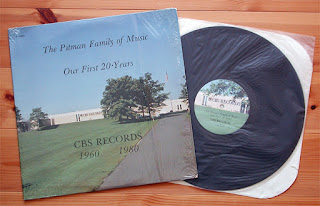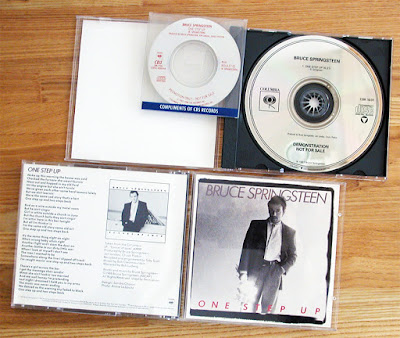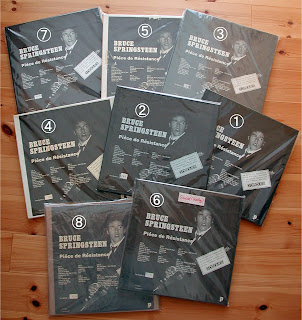 |
The first pressing box release has been said to be limited to 450 numbered
copies. I have long wondered how that number was known. |
On par with
PIÈCE DE RÉSISTANCE, another FM-sourced, dynamic triple-vinyl LP release of
LIVE IN THE PROMISED LAND is often referred to as the greatest vinyl Springsteen bootleg of all time. Which title is better depends on personal preference, or when and how one obtained each copy, as every collectible purchase has its own story (my vote goes to
PIÈCE DE RÉSISTANCE). The reason why I here mention the other classic Bruceleg from the same 1978 tour is that this release also comes with the
Slipped Disc Records label on each vinyl disc. This is no wonder because the two titles are made by the same bootlegger (commonly called Vicky Vinyl). To my knowledge, however, no
generic yellow label version does exist for the first box and second gate-fold issues of
LIVE IN THE PROMISED LAND. Assuming that my knowledge is correct, what is the implication of this fact to the topic here? (i.e.
Which label, specifically generic yellow or custom Slipped Disc Records, is the first on PIÈCE DE RÉSISTANCE ?)
According to the
Blinded By The Light book (P. Humphries & C. Hunt, 1985, Plexus, London),
LIVE IN THE PROMISED LAND is initially released as a limited edition box with the insert, which is similar to the package of
PIÈCE DE RÉSISTANCE. The deluxe, black and white gate-fold sleeve edition follows as the second pressing, although the three vinyl records are indistinguishable from those of the first box release in terms of sound quality, labels (
Slipped Disc Records), matrix numbers (
BS 2978 A/B/C/D/E/F), and probably all the other aspects. Thus, two differences are obvious in production of these two landmark releases:
-
LIVE IN THE PROMISED LAND is released in two distinct packages (box and double jacket) while PIÈCE DE RÉSISTANCE is the box release only.
- The single record label (Slipped Disc Records) is consistently used for LIVE IN THE PROMISED LAND whereas PIÈCE DE RÉSISTANCE is issued with two completely different labels (generic yellow and Slipped Disc Records).
A possible reason for the two different packages of
LIVE IN THE PROMISED (1) was already explained in the
previous post. In brief, when vinyl discs were pressed and ready for the release, probably the fold-out sleeve was still not finished up. That's why the box set was initially released with the text-only slick insert, and later the double jacket replaced the box when it became available.
 |
One of the second pressing copies of LIVE IN THE PROMISED LAND
erroneously contains Disc 3 from PIÈCE DE RÉSISTANCE (Slipped Disc
version), an indication that these two bootleg records were pressed
or manufactured at the same location somewhere in West Coast |
I think a possible reason to explain (2) is very simple:
PIÈCE DE RÉSISTANCE was released before
LIVE IN THE PROMISED LAND, hence before the custom
Slipped Disc Records label was made available to it. Because of this, the early copies for
PIÈCE DE RÉSISTANCE was probably pressed with the
generic yellow labels.
However, when
LIVE IN THE PROMISED LAND was about to be released, the custom label was ready. Because both bootleg titles were made by V. Vinyl and possibly pressed at the same pressing plant, I guess she just switched the label of
PIÈCE DE RÉSISTANCE from the
generic yellow to the better looking custom version. I have long believed so, and this provides another support for my main claim here (shared with Mr. "D") that
PIÈCE DE RÉSISTANCE is originally issued with the
generic yellow label and then the
Slipped Disc Records edition follows.
However, I happened to know that Clinton Heylin, an authority on Springsteen's recording and bootleg, writes in his book
E STREET SHUFFLE: The Glory Days of Bruce Springsteen and the E Street Band (2012; Penguin Books, New York) that there was
LIVE IN THE PROMISED LAND before
PIÈCE DE RÉSISTANCE, which utterly contradicts my long belief!
"...
They (i.e. Vicky Vinyl and her conspirator; annotated by this blogger) had taken Springsteen at
his on-aired word and had pressed up the Winterland show in its
three-hour entirety. When that three disc set sold well, they issued the
Passaic FM broadcast too, as the memorable Pièce de Résistance ..."
To me, this description is questionable because of the following two points. First, the Passaic concert (19/09/1978; bootlegged in
PIÈCE DE RÉSISTANCE) precedes by almost 3 months the Winterland show (15/12/1978; bootlegged in
LIVE IN THE PROMISED LAND). Second, it seems that
PIÈCE DE RÉSISTANCE circulated as early as around Thanksgiving Day in 1978 (not in 1979), according to collectors who have bought this box set immediately when it was out from West Coast (such collectors' reminiscences are found here and there in some relevant thread or message board focusing on this bootleg LP). So, although not conclusive, I guess Heylin's description in this part might be a lapse of his memory.
Unfortunately from my humble point of view, his books such as this and others (notably,
BOOTLEG: The Secret History Of The Other Recording Industry, 1996; St. Martin's Griffin, New York) seem to contain errors and mistakes more than usually, in part probably due to overloading of the information (Don't take that I am challenging him. I like his works that are quite interesting reading). For example, strictly speaking, the sentence in the above quotation
"... had pressed up the Winterland show in its
three-hour entirety" is not accurate because the bootleg lacks the final three encore songs. Another example is found on the same page the above quotation appears in this book, which wrongly
quotes Springsteen's "on-aired word" (i.e. the famous "through the magic of bootleg" comment)
as introduction to
Sandy (it's of course not, but to
Racing In The Street). This error is also found in the
BOOTLEG book.
I think I could write more about these bootlegs but maybe it's time to move to other topics. Finally, I thank Mr. "D" for sharing his thoughts and information, and discussing on this topic, which was really enjoyable.


















